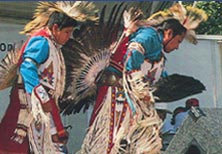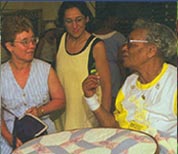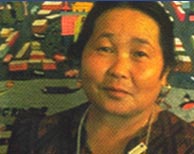| Questions to be Answered |
| What role does storytelling have in families and in households? |
| How are stories passed on from family member to family member or within a household, generation to generation? |
|
- Have a “family story swap” in your class. Help your students get past the potential discomfort of telling family stories by telling some of your own, even if you do not consider yourself a good storyteller. If students are having a hard time thinking of family stories, ask some of the following questions:
- Did your family always live in Iowa? If not, where did they come from originally? How do you know about their migration?
- Did your parents, or other friends or relatives, ever tell you the story of how they met and “courted”?
- What were your first words? Who told you about them?
- What are some of the nicknames of your family members? How were they gained?
- After whom were you named and why?
- When does your family usually tell stories?
- When do your friends usually tell stories?
- Discuss some of the themes that emerge from the family stories. What are the similarities and differences? Why do students think stories are important to families? Is there a connection between the family stories of Iowans and the history of the state?
Each student then picks a story of his or her own, or one told by a classmate, and writes a short essay about the story. The essay should:
a. “Set the stage” for the story, such as, “This story was told to me by my Uncle Joe at our family reunion. . . .”
b. Recount the story.
c. Comment on the importance of the story to the family involved.
- Interview family members or close friends to gather more family stories. Possibilities include interviewing one person in the family who is a good storyteller, gathering a group of family members together for your own “story swap,” or interviewing several family members separately on one theme and comparing versions (for instance, pick a funny family incident and collect stories from three different family members about the incident). Write a summary of your interview(s). What did you learn from collecting these stories?
- Locate some family photographs if possible. Sit down with someone in your family and have him or her tell you about the pictures. Among the possibilities consider photo albums, the students’ own baby pictures, the photos on your piano or mantel, or other photo keepsakes. Pick several photos and write captions for them using the information you collected.
Pair up students and seniors for swapping family stories. Pick a theme that has some common ground, such as stories of family birthday celebrations, relations with siblings, funny or interesting relatives, the family’s move to a new house, etc. Using the stories, discuss with your partner how things have changed and how things remain the same over the years.
| |
| |
|
Photo |
|
|
|
| |
LESSON 2.1 |
|
| Shoua Her is a Hmong woman who moved from Laos to Thailand to Oskaloosa with her family in the 1970s. What kinds of stories do you think she brought with her? |
| |
|
PHOTO BY STEVE OHRN |
|
|









